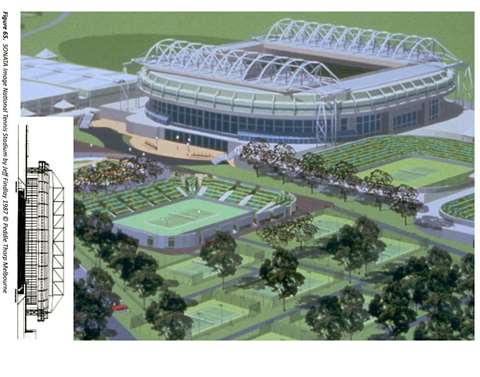Father of BIM: ‘AI will one day be able to design a building for you’
13 March 2023
Dr Jonathan Ingram has become known as the ‘father of BIM’ for designing and writing the first building information modelling (BIM) systems, including Sonata and REfLEX.
He also taught the first BIM courses at Harvard University and won the Prince Philip Gold Medal from the Royal Academy of Engineers for his work.
He tells Neil Gerrard how artificial intelligence (AI) and augmented reality (AR) could revolutionise the way construction professionals design and build buildings – and what needs to change before that happens.
Why has BIM become so important to construction?
There were a number of problems with construction before BIM. One was the co-ordination of information.
 Dr Jonathan Ingram (Image courtesy of Jonathan Ingram)
Dr Jonathan Ingram (Image courtesy of Jonathan Ingram)
You would have separate plan drawings, elevation drawings, and quantities being done by different groups of people in different offices and there was no physical link between them.
This could lead to expensive errors, for example, the windows being in the wrong place. That information needed to be coordinated.
BIM provides consistent information in terms of drawings and physical data.
Data is not duplicated in a true BIM system. You have one source of data, which is correct.
Engineers, architects, services workers all work in their own silos.
BIM enables them to share their space, which is critical to the design.
It is instantaneous and interactive.
This enables the design process to be shortened, guaranteed to be correct, and gives you more opportunity to correct as you go along.
It means zero changes in the construction.
You have written a book called ‘Understanding BIM: The Past, Present and Future’. Does that mean that you feel BIM is not yet well enough understood among construction professionals?
BIM has become complicated.
Basic BIM is really quite straightforward but what has happened is that it has been added to and added to and many modern BIM systems have become overengineered.
The core system has not changed fundamentally from the code I wrote in 1992-3.
But it is difficult to understand because it has become so complex. In my book, I am trying to show why BIM exists, how it evolved, and where it is going in the future.
I am currently working to apply information modelling into retail. We have a successful American company called 345.global where we apply all these information management (IM) principles to retail.
We also use artificial intelligence (AI) and augmented reality (AR).
How would you rate the construction industry’s progress in terms of taking up digital tools like BIM?
They have done well enough. I don’t blame the construction industry for the slow progress, it just too difficult and to some extent too specialist and heavy for your average designer.
It has been 40 years and it was a very hard sell in the early days, trust me.
When you have various people using a system, it is very easy to get the next person to use the system.
When no-one is using it, then finding people to use a system which is meant for sharing is hard.
But BIM needs a good rewrite to bring it into the modern environment and to make it comprehensible, intuitive and powerful.
How does BIM need to evolve for the modern environment?
You want an interface which is modern, simple, which is web-based rather than on heavy lumps of code.
You want a cloud-based shared database.
And you need to have a truly open system.
Having the Industry Foundation Classes (IFC) and Construction Operations Building Information Exchange (COBie) helps but you need to have an open database to truly progress.
You want to be able to let the AI guy do the optimization or to add his bits around that. But if you only allow IFC, which is basically a 3D model, you are losing information from the BIM.
A BIM model is a lot more than a 3D model. For instance, it includes connectivity between the objects; A window needs to know it is in the wall and the wall needs to know the shape of the window, what type of closures and so on. The ducts need to know they are talking to each other and how they are connected.
To move forwards, this type of information needs to be made available and the only true way to do that is with an open database.
You have talked about wanting to harness new technologies to make BIM into a ‘fully cognisant’ system in the future. What does that mean for construction professionals?
 A screenshot from Ingram’s book showing a Sonata image of the National Tennis Stadium by Jeff Findlay from 1987. (Image: Peddle Thorp Melbourne)
A screenshot from Ingram’s book showing a Sonata image of the National Tennis Stadium by Jeff Findlay from 1987. (Image: Peddle Thorp Melbourne)
I have spent the last couple of years writing code and designing systems to do with artificial intelligence (AI) and augmented reality (AR) in retail BIM.
These new technologies provide a wonderful toybox of what you can do in construction in the future.
You want to be able to say to the system: “Design me a building that looks like it was designed by Richard Rogers”.
I was using [AI image creation system] DALL.E the other day and said: “Design me an aircraft carrier that looks like it was designed by Richard Rogers.”
I tried it with buildings too and unfortunately it is not there yet.
I have also been playing with ChatGPT to try to work out its possibilities as a serious tool.
Those tools aren’t there yet but they are coming.
Soon, AI and AR will be able to help design the building and check what you have done.
I am a great believer the human voice rather then going through multiple confusing menus.
In the future, you will be able to ask the system: “How do I do this?” or “Show me the windows I used in the last project.”
At this very minute I am doing coding with Google Dialogflow, which is an intent-based voice recognition system. It brings huge possibilities as to how systems can be improved.
How do you feel about your reputation as the ‘father of BIM’?
I am very proud of the work I have done.
I have sweated with many projects over several systems and several decades.
At the very beginning I sat alone (in an attic) writing the code for the first BIM system, Sonata, and that system was in use until 2015, helping to complete many thousands of major projects around the world.
I am very pleased and proud to be known as the father of BIM and I am continuing to work on progressing information modelling into the future.
STAY CONNECTED



Receive the information you need when you need it through our world-leading magazines, newsletters and daily briefings.
CONNECT WITH THE TEAM








